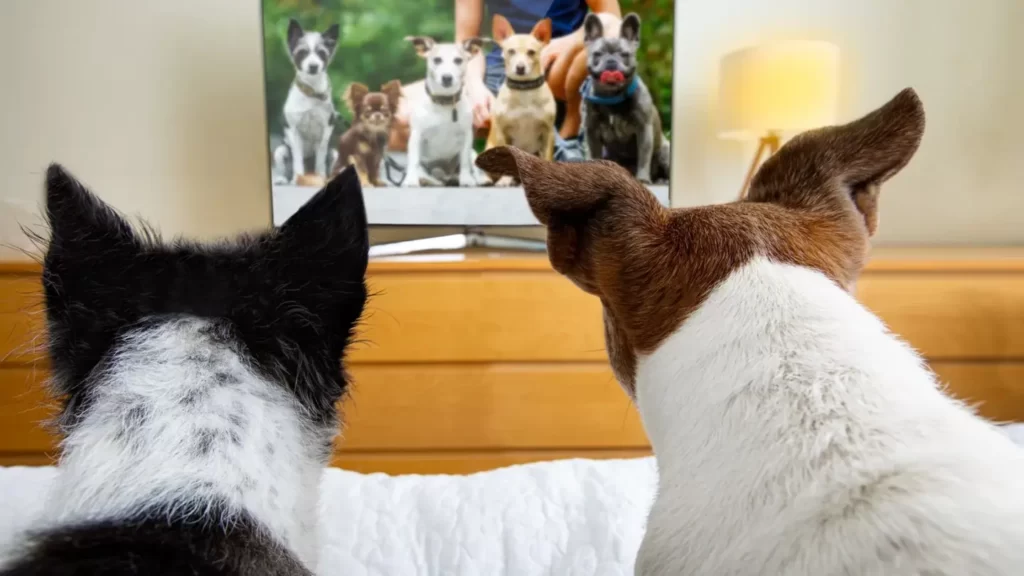About the Author: Dr. Finlay Tayler (DVM), a Harvard veterinary graduate, brings his five years of diverse experience to MyPetDoggie. Passionate about all animals, and a proud dog owner, he balances full-time veterinary practice with contributing expert insights to our content. Dr. Tayler’s love for the outdoors, cycling, and love for dogs enrich his holistic perspective on dogs care.
Are you planning a visit out of town, and can’t afford to travel with your dog, and now missing his cozy hugs already? It’s indeed a challenge living without your pet when he’s a lovely dog. There’s a famous saying,” Something is better than nothing’’ and it’s best applicable when you’ve got an option to Facetime your dog, and make your day beautiful by the sight of his lovely face.
So, Can dogs recognize you on Skype, tablet, or TV?’ Like most dog parents, this question might have often popped up in your mind.
Dogs can recognize you in an image but not on Facetime, Skype, Tablet, or TV Screen because dogs are dichromatic means they can recognize two colors; blue and yellow. Also, they have a high flicker rate of 70/80 Hz thanks to their wolf ancestors. Though, you can give it a try on your buddy.
Actually, there are different factors to consider before assuming that dogs can recognize you on screen or not.
Visual Perception Difference
Visual perception of your dog matters a lot, and it greatly differs among dog breeds and individuals of the same breed. The Genetics of your dog determines how sharp visual perception your dog has.

Dichromatic
Let me tell you one interesting fact about dogs. Dogs are dichromatic, having two types of tones, which means they can recognize two colors i.e. blue and yellow. They aren’t capable of differentiating versatile colors and red-green blinded and see them as brown and black.
So, whatever your dog sees on screen is limited by his visual acuity. He perceives not as clearly as you from the screen.
High Flicker Rate
Your dog may not perceive you accurately on screen because dogs have a higher flicker rate than humans. If you’re not familiar with what the flicker rate is, let me tell you that simply it counts how fast a light blinks or a picture moves in a second on TV.
As dogs have a higher flicker rate of 70/80 Hz, unlike humans who have 50/60Hz, they see terrible flickering on the screen unless a modern technology-incorporated screen is used that has a flicker rate of 100 Hz or higher. Your dog can distinguish fast-moving objects and the ability to discriminate at a higher flicker rate because of the awesome rods in the eyes.
Familiarity with Technology
Did you ever think that the familiarity of your dog with technology matters in the first place? Well! Your dog imitates what you make him learn. He gets used to things you make him accustomed to.

If you’re moving out without your dog, and haven’t made him comfortable around tech devices already, don’t expect him to be excited on Facetime with you. So, what I suggest in light of my studies of the sayings of a veterinary behaviorist working for DOGTV is to keep your dog in the proximity of tech devices such as phones, TV screens, and cameras. Make sure he’s comfortable, and you can introduce screen time as a token of appreciation or as a treat for your good boy. This will help him learn to respond to you on screen, and he’ll not associate negativity with it.
So before you start training your dog without any recently updated protocols for Dog-Computer interaction( DCI), let me tell you some important considerations to keep in mind:
Prioritize Consent
You know dogs don’t have clear consent-giving signs, and unless you’re a professional behaviorist, you can’t decode his body language perfectly. So, if your dog moves away repeatedly, don’t push him into that uncomfortable environment again.
Don’t Play Distressing Sounds and Footage
Your dog’s safety and well-being should be your top priority, and ensure it doesn’t introduce him to any hostile element like distressing footage and sounds for fun. This will deeply affect his mental health, and he’ll be terrified.
Be Present with Your Pup
No matter how dog-friendly the environment looks, don’t trust it completely. If you’re around your dog while he’s learning how to use the machine, it’ll enhance his confidence, and in case of any anxious situation he encounters, he knows whom to return to.
Prefer Dog’s Home Space
Always prefer training your dog in his space, so he feels at home. Just in case, it’s not feasible, and you’ll have to place him somewhere else and then provide him a safe space. You can ensure it by placing your dog’s bed or blanket there to ensure his emotional comfort.
Size of Screen
A contributing factor that enables your dog to recognize you on screen is the size of the screen.
A large-sized screen that has enabled modern technology like LCD has fluorescent lamps flickered at 100 Hz to 120 Hz. However, the newly fluorescent backlit LCD has a flickering rate of 25kHz to 60kHz which is far beyond the dog and human discern.
You know, most dogs don’t feel interested in mobile screens because their visual acuity doesn’t allow them to. Thus, always acclimatize your dog initially with a larger screen.
Audio Cues
Audio cues are the most important factor that helps your dog to recognize you on a digital screen. The reason behind audio cues being the finest contributor is that your dog has extraordinary hearing ability. A dog’s ears are composed of 18 muscles, and his ears are naturally designed in a way that they hear such voices that our human ears can’t perceive.
Your dog has the superpower to tilt and rotate his ears to adjust his ear position to listen to voices that are inaudible to their owners. A canine’s ear canal is longer than us humans. Also, you might have noticed that some breeds have funnel-shaped outer ears that help them to locate voices in inner ears, and enhance their magical hearing ability.
You know dogs remember voices and associate them with smell and visuals. But remember that some breeds of dogs are more susceptible to deafness. Many dogs get hearing loss at a young age, while other dogs develop it in old age. So, if your dog has a hearing issue, sadly, there’s less chance that he’ll recognize you on video chat because an experiment revealed that dogs recall their owner’s face upon hearing the owner’s voice.
That’s how audio cues are the finest stimuli that can make your pet recognize you on the digital screen. Even visuals can’t be that helpful for him, because the low quality of images produced on the screen, flickering, and color combination might not let him fully confident in his sight, but the moment he listens to you calling his name affectionately, he’ll be excited enough to dance on his toes.
Individual Dog Difference
On an individual level, differences in dogs occur due to their different learning and cognitive abilities. Every dog is different, and it’s no less than a myth that every dog of a breed is the same.
Dogs have different personalities, and their individuality is determined by many factors like genetics and the environment he’s pet in. Even the temperament and training strategies of trainers help them to shape a unique personality.
Apart from having unique cognitive abilities, each dog differs physically too. Some of the dogs have been going through deteriorating health conditions, and it, often, remains unnoticed, but, it counts a lot when you’re unconsciously comparing your dog with someone else’s pet. A dog’s health and sharp cognitive abilities set his mood right in terms of learning fast.
Thus, if your dog isn’t learning to talk to you via video chat the way your bestie’s dog does, don’t mind him. Keep things slow and steady, and you’ll observe your dog’s growth.
Training and Familiarity
I believe you must ensure yourself with regular checkups that your dog is doing great, and after that, you start getting him trained by following all the DCI(Dog Computer Interaction) rules.
Training helps your healthy dog to learn. Before burdening him with a training routine, make sure he gets familiar with the tech objects. Start by placing tech objects like tabs, and phones near him when he’s enjoying treats, or getting cuddles from you because this will make your dog associate tech objects with positivity, and he’ll not be terrified of them.
Dogs are made up of discipline I must say. How well you train your dog depends on the punctuality of the training schedule. With the right guidance and proper training techniques, your dog will learn Facetiming you.
Positive Reinforcement
You might have seen those adorable videos on the internet where dogs are lovingly gazing and responding to their owner’s commands on video chat. Dogs become acclimated with tech objects and reach conversational points with their owners on video chats where they’re right trained.
Training gets 100 times better when you apply the technique of positive reinforcement. By positive reinforcement, I mean you must treat your furry friend with his favorite food, cuddles, or whatever he loves when he obeys your commands on a video chat. A proven method of learning is demonstration learning. If your dog sees you face-timing, he’ll not feel strange and clueless about talking with you via screen. Repeatedly exposing your dog will help him learn to respond via Skype, and that will be reinforced by your positive attitude.
What Do Dogs See Behind the Screen?
Often dogs are seen practicing their habit of going behind the screen mostly when they’re on a video call with their owners. There’s nothing to freak out about it. Dogs have rod-dominated retinas, and they don’t perceive the sight of a screen like we humans do. Honestly, their eyes don’t find screen sight friendly, because the old used technology in digital screens has a lower flicker rate, which uncomfort your dog and terrifies him.

Dogs are dichromatic and are blind to most of the colors. Thus screen displays have a color contrast that dogs can’t comprehend. Also, he’s not as intelligent as us humans, and when his visual acuity allows him to see your face on the screen, he perceives you’re behind the screen because a body-less face isn’t an appealing sight for him. Thus to solve this mystery and find you there, your dog goes to see behind the screen.
How Do Dogs Recognise Dogs on TV?
Isn’t it surprising that your dog can recognize fellow dogs on a TV screen? You might be interested to know how your furry friend is intelligent enough to recognize his distant cousins so easily.

By using the same method used on humans to track vision, it’s found that dogs love watching certain videos. It’s observed that dogs prefer watching canines on screen. Quite interesting research published in Springer’s journal Animal Cognition judges dogs’ ability to recognize fellow dogs from the pool of pictures of humans. dogs, and other animals. Dogs can recognize other dog’s faces irrespective of their different breeds and put them all in the same category.
But let me break it to you the ability of your dog to recognize other dogs depends on his marvelous inborn ability to listen. Your dog can easily get familiar with the sounds, and the moment he listens to barking dogs on TV, you can see his muscles twitching with excitement, and it’s a sign to you that your pup has recognized his cousins on TV.
Common Question:
Can dogs see what’s on your screen?
Your pup can see what’s on your screen, but keep in mind every dog is different and it depends on two factors what they can see on screen. The genetics of your dog determine how great his vision is, and the technology incorporated into your screens creates a huge difference. Older TVs with CRT screens aren’t less than a flicker nightmare for your pup, but new LEDs have fixed it for the dogs.
Why does my dog not notice the screen?
Many dogs are adapted to viewing TV, while others aren’t. Hunter dogs like Labrador Retrievers keenly watch TV because they see moving objects on the screen more intriguingly. While some dogs love lying down and enjoying the sound of TV as resting music. Generally, dogs are fidgety interactive viewers, and you might notice them moving close to the screen. So, chill with your pup, and don’t worry if he doesn’t behave like your neighbor’s dog.
What colors can dogs see?
Your dog is dichromatic and can discern blue and yellow colors easily. Your pup is green-red-blinded, and can’t differentiate between them. So, if you’re thinking of buying him a cute toy, I’ll recommend you prefer a blue colored toy because it looks most appealing and vibrant to him.
Do dogs Like TV or music?
It depends on your dog’s lifestyle and whether he likes TV/music or not, you’re the favorite thing for your dog when you’re around. However, if you’re planning to home alone with your furry friend, he’ll playfully like watching TV and relaxing music to avoid separation anxiety.
Why do dogs hate phone cameras?
Your dog is probably camera-shy and doesn’t like to be clicked even though you find him extra cute. One of the reasons is that your dog is uncomfortable in the proximity of your phone. The other reason is they find the camera lens a foreign object that wants to pick a fight with him by staring at him. Last but not least dogs are sensitive to the camera shutter sound.
Do dogs recognize their owners’ voices?
Yes, dogs can easily recognize their owners’ voices without any hurdles. Research conducted shows that dogs can not only recognize their owners’ voices but also generate visual stimuli with the help of auditory information.
Can dogs hear phone calls?
Yes, dogs can hear phone calls as they have highly developed hearing abilities. They can hear a sound as low as having a 4Hz frequency. So, make a call to your dog, and he’ll be delighted to hear from you.
Ending Note
All dogs are different and unique. Recognizing the owner on a digital screen isn’t in the genetics of dogs yet. But, if you train your dog professionally by following all DCI protocols, and ensure the results by positive reinforcement, he’ll learn to recognize you on a digital screen.
I hope you’ve realized that the sense of hearing and smell are the stronger senses of your dog as compared to his visuals. Thus, he prefers using his strength like hearing to follow the verbal cues you say on video chat and confirm your presence on screen by your voice. He cannot trust his sight fully, because sometimes flickering digital screens and unfamiliar colors confuse him.
Last but not least, keep in mind that Facetiming is just a way to see your dog’s lovely face, and if he doesn’t respond to you as expected, don’t lose heart, and don’t force technology on him, because we don’t aim to turn our dogs into tech addict, but tech-friendly.






